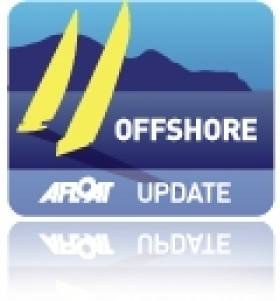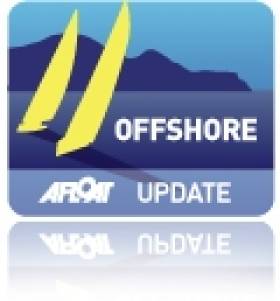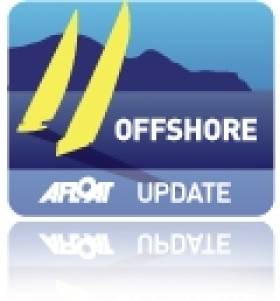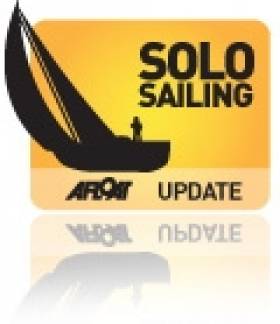Displaying items by tag: Dinah
Hurley & Boyle Lead Middle Sea Double Handers But Time is Running Out
#middelsearace – Dun Laoghaire's Dinah crewed by Barry Hurley and Andrew Boyle is leading the Two Handed Class after time correction but there estimated finish time is 1000 tomorrow; two hours after the time limit expires for this year's marathon Rolex Middle Sea Race.
The cut off time to is 0800 tomorrow and a group of determined sailors are desperately trying to keep that appointment.
Racing the Middle Sea Race Two-Handed is not for the faint hearted.
In reality each member of the team sails the boat alone, whilst the other one sleeps. But there is no rigid watch system, sail changes in this race have been frequent and both crew are required on deck, regardless of whose turn it is to sleep. In short, racing for seven days and nights with just two people is hard-core both mentally and physically.
The vast majority of the 83 yachts have either finished or will do today. However, none of the Two Handed teams is likely to finish tonight. To complete the Rolex Middle Sea Race, yachts must cross the finish line by 0800 tomorrow and four of the Two Handed entries are desperately trying to meet that deadline.
Dinah should speed up after they come off the wind after Lampedusa. If they can make the cut off, the Irish team may win a tremendous victory. Dinah is being pushed hard by Pierpaolo Ballerini & Andrea Caracci's Azuree, The Italian team is neck and neck with Dinah on the water but behind after time correction but the match race will be spurring both of the yachts on.
Leading the Two Handed Class on the water is Matchpoint, crewed by Damir Cargo and Miljenko Nikolic. The Croatian team. Matchpoint has passed Lampedusa and should make the finish in the early hours of Saturday morning, then they must wait to see if any of the other yachts can make it in time.
Second on the water is Atame with Beppe Bisotto & Ian Knight. Atame is 122 miles from the finish and at their current speed will not make the time limit. However, once Atame rounds Lampedusa, they will ease sheets and come off the wind dramatically increasing their boat speed, Atame need to average 7 knots to make the finish, which is possible.
The dark horse in the Two Handed Class is also the largest yacht. Swan 46, Foreign Affair has sailed a significant extra distance to get over to the left hand side of the race course 'banging the corner' in sailing slang. The elegant Swan is crewed by two brothers; Paul & James Basson from Monaco.
Over one thousand sailors have taken part in the Rolex Middle Sea Race and the event has attracted a worldwide audience, hopefully all of the race fans will be willing the determined sailors still racing to make the cut off time by 0800 tomorrow morning.
Irish Yacht Second in Class at Halfway Stage of Middle Sea Race
#middlesearace – Royal Irish Yacht Dinah from Dun Laoghaire is approaching the half way stage of the Rolex sponsored Middle Sea race this morning and is lying second in class in the 83-boat fleet. The yacht is heading west across the north coast of Sicily and making 5.6 knots.
As our exclusive onboard photo shows it's no longer just skipper Barry Hurley and crew mate Andrew Boyle on board, the Irish duo have been joined by a tired (but chirping) sparrow hitching a ride on the rail of the modified JOD 35 yacht.
'We're doing ok in our class although our main competition is now in different weather systems, so we need to work extra hard to keep in contention. Fingers crossed we have what it takes! Hurley told Afloat.ie
The tried and tested Irish craft has already claimed the Round Rockall race this July and it won an Ostar Transatlantic race in 2009. Light air conditions are prevailing for this race which started on Saturday.
'The last few days have been the slowest yet most intense racing I can remember. We dread the thought of being timed out after all this effort, but still cling to the hope of finishing within the time limit' he said.
The stress is somewhat compensated by the amazing scenery though admitted Hurley. 'After a night watching molten lava flowing down the side of Stromboli into the sea, we were treated to an amazing sunrise'
The other Irish entry Gallileo skippered by Des Kelliher with various crew from this year's ISORA series onboard retired from the race yesterday.
Late last night, Esimit Europa 2's skipper Jochen Schümann showered the Maxi crew with champagne dockside at the Royal Malta Yacht Club to celebrate taking Line Honours for the third consecutive year in the Rolex Middle Sea Race. Schümann has won Olympic Gold and The America's Cup but the ardour of the victory was etched on his face.
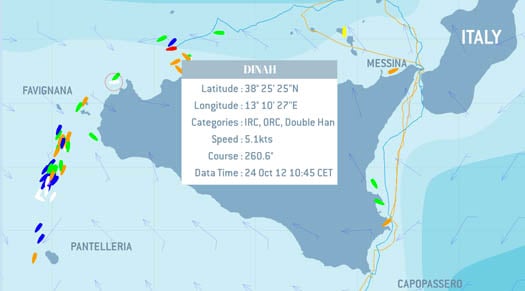
Dinah's latest position
"That was a tough one," explained Schümann. "We got caught up by Ran and Stig in the first parking lot at Stromboli but it was by no means the last. Our primary goal was line honours and it was impossible to relax during any part of the race. We are delighted to have taken line honours and finish of a great season in style."
It was nearly seven hours before Niklas Zennstrom's JV 72, Ran crossed the finish line, setting the bar for the rest of the fleet to achieve. Although this has been a slow race, Ran have put in a magnificent performance to lead a highly competitive Class 1 and lay claim to an overall win.
"Before the race we sat down as a crew and said this would be frustrating at times; at one stage we looked like we would finish on Friday and we only had food until Tuesday evening but we stayed together as a team and had plenty of time to tell a few more jokes over the last four days. Clearly we were racing Stig this race because we are very similar boats and we were very very close until the second half of the race when we managed to get away from them. But the fact that we had someone to race against made the race much more fun. We are in good shape for our class and in reality that is all that you can do and the rest is up to the conditions, so now we will have to see what will happen."
Whilst Esimit Europa are assured of Line honours and Ran look very likely to win Class 1, the overall winner is very much undecided. All of the yachts in contention are now past Favignana, which gives a good indication of the fleet's overall standings but only an indication. However, now that Ran has finished, we can state the exact time that others need to finish to beat their time.
In Class 4, Lee Satariano & Christian Ripard's J/122 Artie RTFX with an all Malta crew were leading their class and the Rolex Middle Sea Race overall at Favigana. To beat Ran's corrected time Artie RTFX need to finish on 26 October by 02:10:52.
The Class 3 leader, Josef Schultheis & Paolo Semeraro Xp44, XP-ACT was second overall at Favignana. On board are three Maltese crew; Sebastian Ripard, Timmy Camilleri and Zach Cassar Torregiani. To beat Ran's corrected time XP-ACT need to finish on 25th October by 20:32:22.
Third overall at Favignana and second in Class 3 was the Sicialian Mylius, Zenhea Takesha, skippered by Natale Lia. To beat Ran's corrected time Zenhea Takesha need to finish on 25th October by 14:04:25.
Fourth overall at Favignana and leading Class 2 was the South African entry, Hi Fidelity, skippered by Eddie De Villiers. To beat Ran's corrected time Hi Fidelity need to finish on 25th October by 11:14:39
Fifth overall and third in Class 3 was Jonas Diamantino's all Maltese crew on Comanche Raider II Gasanmamo. To beat Ran's corrected time Comanche Raider II Gasanmamo need to finish on 25th October by 19:58:29.
Other news from Maltese yachts on the race course; Arthur Podesta's Elusive 2 called into the media centre last night.
"We are approaching Favignana, managing just half a knot of boat speed. I recall that it took us seven days to complete the first race back in 1968 but in these modern boats, this is the slowest race I can remember. We are running low on luxury food, only one more egg and bacon fry up remaining and we have started to boil and bottle tank water just as a precaution. It is difficult to keep motivated when we are going so slowly and have few boats around us."
Jonas Diamantino, skipper of Comanche Raider II Gasanmamo called the media office at 0900 this morning; "Unfortunately we have an injury on board and also some sail damage. Ramon Sant Hill, my co-skipper has gashed his left hand, we have disinfected it and put 5 butterfly stitches in it, luckily it is not his drinking hand! Also we have damaged our Code Zero, a very useful sail at the moment that we did not have up for three hours."
Irish Two Handed Entry Ready for Middle Sea Challenge
#middlesearace – The winner of this Summer's inaugural Round Rockall offshore Race is in Malta tonight preparing for Saturday's Middle Sea Race, an event that is preceded for Barry Hurley's Dinah by tomorrow's warm up coastal race.
The Dun Laoghaire two-handed entry, a JOD 35, is ready for the weekend challenge and is one of at least two Irish entries involved.
"I have sailed nearly 3000 miles to get here but this is not my first race, I have competed six times before, often with Maltese boats and I have very fond memories of those races. This year, I had the chance to come here and sail in my own boat and I am really looking forward to a great race.
Hurley is an experienced campaigner. Sailing Dinah, he finished the 2009 OSTAR (singlehanded transatlantic race) in Newport, Rhode Island, USA as a class winner after 21 days at sea.
With less than 5 days to go to the start of the 33rd edition of the Rolex Middle Sea Race, a steady stream of boat captains have been making their way to the Royal Malta Yacht Club making their final registrations for the race. Yachts from 18 different nations are taking up their berths at The Royal Malta Yacht Club and the Grand Harbour Marina. The extensive facilities at the club will be put to good use, as Thursday night's Crew Party, will cater for 1500 invited guests. Racing starts tomorrow (Wednesday 17th October) with a coastal race in preparation for the main event, which starts on Saturday 20th October.
At a packed press conference held on the terrace of The Royal Malta Yacht Club, the Commodore, Godwin Zammit introduced Principle Race Officer, Peter Dimech who explained the planning that has been put in place to start The Rolex Middle Sea Race from the historic Grand Harbour.
"It is too early to establish exactly what the weather will be like on Saturday but there is no doubt that the Grand Harbour will be extremely busy with competing boats. Transport Malta has closed the harbour to other shipping from 0830 until 1300 and we would specifically ask that any vessels that are in Grand Harbour keep well clear of the competing yachts. We are especially grateful to Transport Malta and the Armed Forces of Malta, who have been extremely co-operative, with a record number of yachts expected on the start line, we would anticipate that there will be four or five different starts, probably the best view will be from the Upper Barrakka Garden, I am sure it will be an amazing spectacle."
The press conference was attended by a number of Maltese and overseas skippers taking part in the race.
Lee Satariano, the co-skipper of last year's overall winner, Artie-RTFX:
"I think if anything we are actually better prepared than last year and we have been working hard on our performance and hope we can do ourselves justice but above all we are looking forward to enjoying the race, once again the entire crew is from Malta."
Arthur Podesta, skipper of Elusive 2 has done them all, competing in every race since 1968:
"This race was always designed to be a classic Mediterranean race and that is what it has become, the first race had only 8 boats and it has just got bigger every year. It is a fascinating race, maybe you could say it is six races rather than just one, as the course is so changeable, it always keeps one interested."
Volvo Ocean Race skipper and Olympic sailor, Andreas Hanakamp will be racing on the Austrian Class 40, Vaquita:
"I am not surprised that this race has become so popular, there are six Austrian yachts racing, which is great to see. The race has fantastic scenery and it is a very challenging course, which makes it really attractive and has established it as a classic not to be missed."
Tomorrow, Wednesday 16th October. The Royal Malta Yacht Club is organising a coastal race. Scheduled to start at 1000, the coastal race offers the teams an opportunity to practice before the big send off on Saturday. The course is likely to be approximately 16 miles, starting from Marsamxett Harbour then up the northwest coast of Malta around Comino and finishing in front of the Royal Malta Yacht Club. Spectators will be able to watch the race from along the Sliema seafront at the start and the finish. During the coastal race, the Gozo Ferry terminal at Ċirkewwa will offer views of all the boats as they round Comino.
It is also highly likely that the Slovenian Supermaxi, Esimit Europa 2 will arrive in Malta during the course of tomorrow's coastal race. Esimit Europa 2 is aiming to establish the benchmark time for the 700 nautical mile passage record Trieste to Valletta, recognized by the World Sailing Speed Record Council.
SORC Success for 'Dinah'
The annual Solo Offshore Racing Club's 'Channel Week' was held last week in a varying mix of conditions. Seven offshore legs over eight days took the fleet from the Solent to the Channel Islands, and on to three French ports, before crossing back to the Weymouth and finishing in the Solent. Conditions were challenging throughout the event, including everything from a 100m beat to Guernsey in 25+knts and spring tides, to a light airs run from Weymouth to the Solent on the final day.
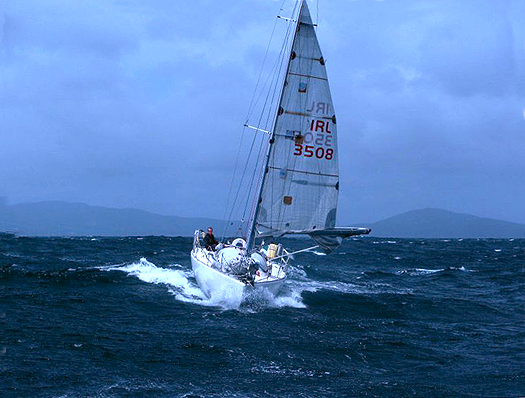
The much travelled 'Dinah' owned and skippered by Barry Hurley from the Royal Irish Yacht Club put in a strong performance over the whole week, scoring no lower than 2nd in class in every race. Consistency proved key in the no discard series, with Hurley eventually finishing 1st in class and 3rd overall. Hurley commented, "It was a fantastic event, with long legs in difficult conditions, leading to very short stopovers to recover and carry out routine maintenance. Boat preparation was key with several entries suffering breakages along the way. In the end I needed a win on the last day to guarantee a win in class overall and I got a great start before making the most of the positive tide by gybing several times under full mainsail and symmetric spinnaker. My main rival chose the shorter straight line route, but thankfully the option of longer distance in more tide paid off in the end. I'm delighted with the result."
In a few weeks time on August 14th Barry will be joined again by his usual crew Andy Boyle, also of the Royal Irish Yacht Club, as they set off on the Rolex Fastnet Race double handed against a fleet of over 350 boats.
Big ISORA Fleet Gathers for M2 Buoy Race
- Dinah
- Dublin Bay
- Just Enough
- Lula Belle
- ISORA
- National YC
- irish sea
- English Mick
- Quite Correct
- Galileo
- African Challenge
- Lancastrian
- Tsunami
- Rebellion
- Orna
- Madam Wen
- Rollercoaster
- Raging Bull
- Miss Scarlett
- Team Windmill
- First of September
- Finnigans Wake
- Windshift
- Mojito
- Adelie
- Gwawr
- Yahtzee
- Legally Blonde
- Katanca
- Oystercatcher
- Obsession
- Sarnia


























